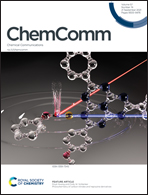New horizons in low oxidation state group 2 metal chemistry
Abstract
Since the seminal report on Mg in the +I oxidation state in 2007, low-valent complexes featuring a MgI–MgI bond developed from trophy molecules to state-of-the-art reducing agents. Despite increasing interest in low-valency of the other group 2 metals, this area was restricted for a long time to a rare example of a CaI(arene)CaI inverse sandwich. This feature article focuses on the most recent developments in the field, highlighting recent breakthroughs for Be, Mg and Ca. The more exotic metal Be was the first to be isolated as a zero-valent complex which could be oxidized to a BeI species. There also has been interest in breaking the MgI–MgI bond with superbulky β-diketiminate ligands (BDI) that suppress (BDI)Mg–Mg(BDI) bond formation. This led to Mg–Mg bond elongation or Mg–N bond cleavage. Several reports on attempts to isolate (BDI)Mg˙ radicals by combinations of ligand bulk, addition of neutral ligands or UV(vis) irradiation led to reduction of the aromatic solvents, underscoring the high reactivity of these open shell species. Only recently, zero-valent complexes of Mg were introduced. Double reduction of a (BDI)MgI complex with Na gave [(BDI)Mg−]Na+. This Mg0 complex crystallized as a dimer in which the Na+ cations bridge the two (BDI)Mg− anions which react as Mg nucleophiles. Thermal decomposition led to spontaneous formation of Na0 and a trinuclear (BDI)MgMgMg(BDI) complex. This mixed-valence Mg3-complex is a prime example of the fleeting multinuclear Mgn intermediates discussed on the way from Mg metal to Grignard reagent. Attempts to prepare low-valent CaI compounds by reduction of (BDI)CaI led to dearomatization of the arene solvents: (BDI)Ca(arene)Ca(BDI). Reduction in alkanes prevented this decomposition pathway but led to N2 reduction and isolation of (BDI)Ca(N2)Ca(BDI), representing the first example of molecular nitrogen fixation with an early main group metal. As the N22− anion reacts in most cases as a very strong two-electron reductant, LCa(N2)CaL could be seen as a synthon for hitherto elusive CaI–CaI complexes. Theoretical calculations suggest that participation of Ca d-orbitals is relevant for N2 activation. These most recent developments in low-valent group 2 metal chemistry will revive this area and undoubtly lead to new reactivities and applications.



 Please wait while we load your content...
Please wait while we load your content...